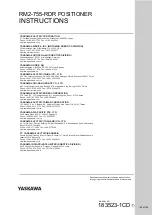
C-16
183523-1CD
183523-1CD
Appendix C
P
RM2-755-RDR Postioner
Performance Level d (PLd)
ISO Performance Level (PL) “d” means that the average probability of
dangerous failure per hour of the safety related parts of the control system
falls within = 10-7 to < 10-6. Additionally, other factors such as proper
installation, maintenance and protection against environmental factors
also apply. This is the minimum performance level specified in ISO 10218-
2 section 5.2.2, unless a risk assessment would allow a lower value to be
used.
Performance Level e (PLe)
ISO Performance Level (PL) “e” means that the average probability of
dangerous failure per hour of the safety related parts of the control system
falls within = 10-8 to < 10-7. Additionally, other factors such as proper
installation, maintenance and protection against environmental factors
also apply.
Pick and Place Cycle
The amount of time it takes for a Manipulator to pick up an object and
place it in a desired location, then return to its rest position. This includes
time during the acceleration and deceleration phases of a particular task.
The robot movement is controlled from one point location in space to
another in a Point-to-Point (PTP) motion system. Each point is
programmed into the robot's control memory and then played back during
the work cycle.
Pick-and-Place Task
A repetitive part transfer task composed of a picking action followed by a
placing action.
Pinch Points
A pinch point is any point at which it is possible for a person or part of a
person’s body to be caught between moving parts of a machine, or
between the moving and stationary parts of a machine, or between
material and any part of the machine. A pinch point does not have to
cause injury to a limb or body part, although it might cause injury – it only
has to trap or pinch the person to prevent them from escaping or removing
the trapped part from the pinch point.
Pitch
Rotation of the end-effector in a vertical plane around the end of the robot
.
Pitch Line
Ideal line of the gear
Play Mode
After a robot is programmed in Teach Mode, the Controller can be
switched to Play Mode to execute the robot program. In Play Mode, the
robot program is played back. This is the mode in which robots are used in
production.
92 of 104






























